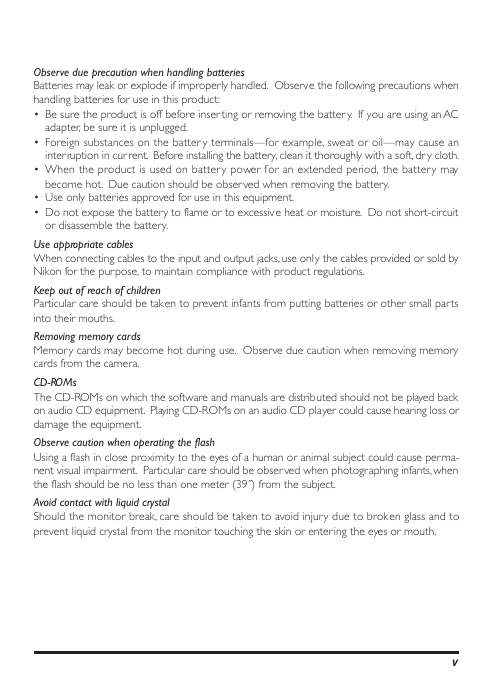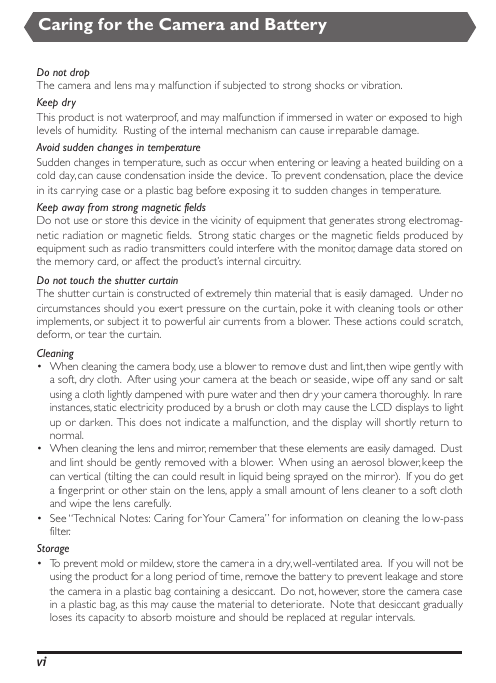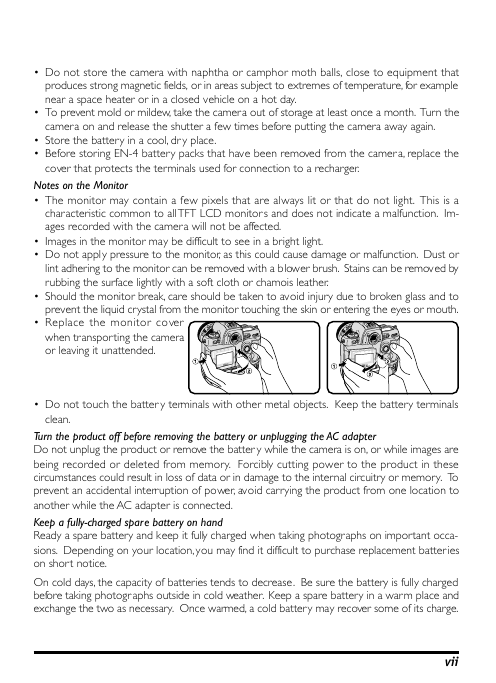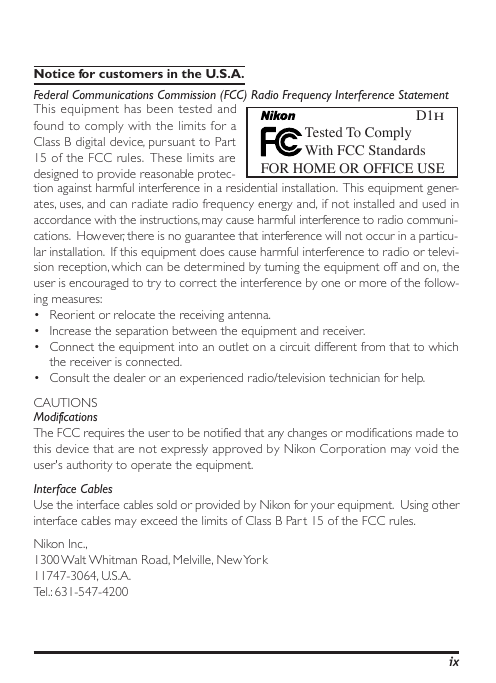About This Manual
Thank you for your purchase of a Nikon D1H digital camera. This manual is designed
to improve your enjoyment of this advanced single-lens reflex (SLR) digital camera.
As you read through it, you will find explanations not only of how the camera works,
but of how certain features can be used to take photographs in a variety of situa-
tions. The manual is divided into the following sections:
• Getting Started ..............................................................................
pp. 1–18
The “Getting Started” section describes the symbols and conventions used in
this manual and provides a guide to the names and functions of camera controls
and icons.
• Tutorial ............................................................................................
pp. 19–50
This section provides sufficient information to master simple “point-and-shoot”
photography. After reading this section, you should know enough about your
camera to enjoy the simplicity and immediacy of digital photography.
• Reference........................................................................................
pp. 51–154
Like the tutorial, the reference section covers the steps involved in shooting and
playback in the order most commonly followed when taking photographs, but
covers these topics in greater depth. Taking playback one step further, it also
describes how to view photographs on a computer or television.
• Custom Settings and Other Menus ..........................................
pp. 155–191
This section details custom settings and provides an index to camera menus.
• Technical Notes.............................................................................
pp. 193–223
Refer to this section for information on optional accessories, camera care, trouble-
shooting, and specifications.
ii
�
• For Your Safety ...............................................................
• Caring for the Camera and Battery ..........................
• Notices .............................................................................
iv–v
vi–vii
iii–xi
• Table of Contents ..........................................................
xii–xiv
• Overview .........................................................................
pp. 2–3
• Getting to Know the Camera.....................................
pp. 4–18
• First Steps ........................................................................
pp. 20–31
• Taking Photographs .......................................................
pp. 32–50
• Advanced Photography .................................................
pp. 52–119
• Playback............................................................................
pp. 120–147
• Connecting Your Camera to a Computer ................
pp. 148–154
• Custom Settings .............................................................
pp. 156–185
• Other Camera Menus ..................................................
pp. 186–191
• Caring for Your Camera ...............................................
• Optional Accessories ....................................................
• Troubleshooting .............................................................
• Specifications ..................................................................
•
Index .................................................................................
pp. 194–197
pp. 198–207
pp. 208–211
pp. 212–219
pp. 220–223
iii
�
For Your Safety
To prevent damage to your Nikon product or injury to yourself or to others, read
the following safety precautions in their entirety before using this equipment. Keep
these safety instructions where all those who use the product will read them.
The consequences that could result from failure to observe the precautions listed in
this section are indicated by the following symbols:
This icon marks warnings, information that should be read before using your
Nikon product to prevent possible injury.
WARNINGS
Do not look at the sun through the viewfinder
Viewing the sun or other strong light source through the viewfinder could cause permanent
visual impairment.
Turn off immediately in the event of malfunction
Should you notice smoke or an unusual smell coming from the equipment or from the AC
adapter (available separately), unplug the AC adapter and remove the batteries immediately,
taking care to avoid burns. Continued operation could result in injury. After removing the
batteries, take the equipment to a Nikon-authorized service center for inspection.
Do not use in the presence of flammable gas
Do not use electronic equipment in the presence of flammable gas, as this could result in
explosion or fire.
Do not place camera strap around neck
Placing the camera strap around your neck could result in strangulation. Special care should be
taken to avoid placing the strap around the neck of an infant or child.
Do not disassemble
Touching the product’s internal parts could result in injury. In the event of a malfunction, the
product should be repaired only by a qualified technician. Should the product break open as
the result of a fall or other accident, remove the batter y and/or AC adapter and then take the
product to a Nikon-authorized service center for inspection.
iv
�
Observe due precaution when handling batteries
Batteries may leak or explode if improperly handled. Observe the following precautions when
handling batteries for use in this product:
• Be sure the product is off before inser ting or removing the batter y. If you are using an AC
adapter, be sure it is unplugged.
• Foreign substances on the batter y terminals—for example, sweat or oil—may cause an
interruption in current. Before installing the battery, clean it thoroughly with a soft, dr y cloth.
• When the product is used on battery power for an extended period, the battery may
become hot. Due caution should be obser ved when removing the battery.
• Use only batteries approved for use in this equipment.
• Do not expose the battery to flame or to excessive heat or moisture. Do not short-circuit
or disassemble the battery.
Use appropriate cables
When connecting cables to the input and output jacks, use only the cables provided or sold by
Nikon for the purpose, to maintain compliance with product regulations.
Keep out of reach of children
Particular care should be taken to prevent infants from putting batteries or other small parts
into their mouths.
Removing memory cards
Memory cards may become hot during use. Observe due caution when removing memory
cards from the camera.
CD-ROMs
The CD-ROMs on which the software and manuals are distributed should not be played back
on audio CD equipment. Playing CD-ROMs on an audio CD player could cause hearing loss or
damage the equipment.
Observe caution when operating the flash
Using a flash in close proximity to the eyes of a human or animal subject could cause perma-
nent visual impairment. Particular care should be obser ved when photographing infants, when
the flash should be no less than one meter (39˝) from the subject.
Avoid contact with liquid crystal
Should the monitor break, care should be taken to avoid injury due to broken glass and to
prevent liquid crystal from the monitor touching the skin or enter ing the eyes or mouth.
v
�
Caring for the Camera and Battery
Do not drop
The camera and lens may malfunction if subjected to strong shocks or vibration.
Keep dry
This product is not waterproof, and may malfunction if immersed in water or exposed to high
levels of humidity. Rusting of the internal mechanism can cause ir reparable damage.
Avoid sudden changes in temperature
Sudden changes in temperature, such as occur when entering or leaving a heated building on a
cold day, can cause condensation inside the device. To prevent condensation, place the device
in its car rying case or a plastic bag before exposing it to sudden changes in temperature.
Keep away from strong magnetic fields
Do not use or store this device in the vicinity of equipment that generates strong electromag-
netic radiation or magnetic fields. Strong static charges or the magnetic fields produced by
equipment such as radio transmitters could interfere with the monitor, damage data stored on
the memory card, or affect the product’s internal circuitry.
Do not touch the shutter curtain
The shutter curtain is constructed of extremely thin material that is easily damaged. Under no
circumstances should you exert pressure on the cur tain, poke it with cleaning tools or other
implements, or subject it to powerful air currents from a blower. These actions could scratch,
deform, or tear the curtain.
Cleaning
• When cleaning the camera body, use a blower to remove dust and lint, then wipe gently with
a soft, dry cloth. After using your camera at the beach or seaside, wipe off any sand or salt
using a cloth lightly dampened with pure water and then dr y your camera thoroughly. In rare
instances, static electricity produced by a brush or cloth may cause the LCD displays to light
up or darken. This does not indicate a malfunction, and the display will shortly return to
normal.
• When cleaning the lens and mirror, remember that these elements are easily damaged. Dust
and lint should be gently removed with a blower. When using an aerosol blower, keep the
can vertical (tilting the can could result in liquid being sprayed on the mir ror). If you do get
a fingerprint or other stain on the lens, apply a small amount of lens cleaner to a soft cloth
and wipe the lens carefully.
• See “Technical Notes: Caring for Your Camera” for information on cleaning the low-pass
filter.
Storage
• To prevent mold or mildew, store the camera in a dry, well-ventilated area. If you will not be
using the product for a long period of time, remove the battery to prevent leakage and store
the camera in a plastic bag containing a desiccant. Do not, however, store the camera case
in a plastic bag, as this may cause the material to deteriorate. Note that desiccant gradually
loses its capacity to absorb moisture and should be replaced at regular intervals.
vi
�
• Do not store the camera with naphtha or camphor moth balls, close to equipment that
produces strong magnetic fields, or in areas subject to extremes of temperature, for example
near a space heater or in a closed vehicle on a hot day.
• To prevent mold or mildew, take the camera out of storage at least once a month. Turn the
camera on and release the shutter a few times before putting the camera away again.
• Store the battery in a cool, dr y place.
• Before storing EN-4 battery packs that have been removed from the camer a, replace the
cover that protects the terminals used for connection to a recharger.
Notes on the Monitor
• The monitor may contain a few pixels that are always lit or that do not light. This is a
characteristic common to all TFT LCD monitor s and does not indicate a malfunction. Im-
ages recorded with the camera will not be affected.
• Images in the monitor may be difficult to see in a bright light.
• Do not apply pressure to the monitor, as this could cause damage or malfunction. Dust or
lint adhering to the monitor can be removed with a blower brush. Stains can be removed by
rubbing the surface lightly with a soft cloth or chamois leather.
• Should the monitor break, care should be taken to avoid injury due to broken glass and to
prevent the liquid crystal from the monitor touching the skin or entering the eyes or mouth.
• Replace the monitor cover
when transporting the camera
or leaving it unattended.
• Do not touch the batter y terminals with other metal objects. Keep the battery terminals
clean.
Turn the product off before removing the battery or unplugging the AC adapter
Do not unplug the product or remove the batter y while the camera is on, or while images are
being recorded or deleted from memory. Forcibly cutting power to the product in these
circumstances could result in loss of data or in damage to the internal circuitry or memory. To
prevent an accidental interruption of power, avoid carrying the product from one location to
another while the AC adapter is connected.
Keep a fully-charged spare battery on hand
Ready a spare battery and keep it fully charged when taking photographs on important occa-
sions. Depending on your location, you may find it difficult to purchase replacement batteries
on short notice.
On cold days, the capacity of batteries tends to decrease. Be sure the battery is fully charged
before taking photogr aphs outside in cold weather. Keep a spare battery in a warm place and
exchange the two as necessary. Once warmed, a cold battery may recover some of its charge.
vii
�
Notices
• No part of the manuals included with this product may be reproduced, transmit-
ted, transcribed, stored in a retrieval system, or translated into any language in any
form, by any means, without Nikon’s prior written permission.
• Nikon reser ves the right to change the specifications of the hardware and soft-
ware described in these manuals at any time and without prior notice.
• Nikon will not be held liable for any damages resulting from the use of this prod-
uct.
• While every effor t has been made to ensure that the information in these manu-
als is accurate and complete, we would appreciate it were you to bring any errors
or omissions to the attention of the Nikon representative in your area (address
provided separately).
Notice for customers in Canada
CAUTION
This class B digital apparatus meets all requirements of the Canadian Interference
Causing Equipment Regulations.
ATTENTION
Cet appareil numérique de la classe B respecte toutes les exigences du Règlement
sur le matériel brouilleur du Canada.
viii
�
FOR HOME OR OFFICE USE
Tested To Comply
With FCC Standards
Notice for customers in the U.S.A.
Federal Communications Commission (FCC) Radio Frequency Interference Statement
This equipment has been tested and
D1H
found to comply with the limits for a
Class B digital device, pur suant to Part
15 of the FCC rules. These limits are
designed to provide reasonable protec-
tion against harmful interference in a residential installation. This equipment gener-
ates, uses, and can radiate radio frequency energy and, if not installed and used in
accordance with the instructions, may cause harmful interference to radio communi-
cations. However, there is no guarantee that interference will not occur in a particu-
lar installation. If this equipment does cause harmful interference to radio or televi-
sion reception, which can be determined by turning the equipment off and on, the
user is encouraged to try to correct the interference by one or more of the follow-
ing measures:
• Reorient or relocate the receiving antenna.
• Increase the separation between the equipment and receiver.
• Connect the equipment into an outlet on a circuit different from that to which
the receiver is connected.
• Consult the dealer or an experienced radio/television technician for help.
CAUTIONS
Modifications
The FCC requires the user to be notified that any changes or modifications made to
this device that are not expressly approved by Nikon Corporation may void the
user's authority to operate the equipment.
Interface Cables
Use the interface cables sold or provided by Nikon for your equipment. Using other
interface cables may exceed the limits of Class B Par t 15 of the FCC rules.
Nikon Inc.,
1300 Walt Whitman Road, Melville, New Yor k
11747-3064, U.S.A.
Tel.: 631-547-4200
ix
�
















 2023年江西萍乡中考道德与法治真题及答案.doc
2023年江西萍乡中考道德与法治真题及答案.doc 2012年重庆南川中考生物真题及答案.doc
2012年重庆南川中考生物真题及答案.doc 2013年江西师范大学地理学综合及文艺理论基础考研真题.doc
2013年江西师范大学地理学综合及文艺理论基础考研真题.doc 2020年四川甘孜小升初语文真题及答案I卷.doc
2020年四川甘孜小升初语文真题及答案I卷.doc 2020年注册岩土工程师专业基础考试真题及答案.doc
2020年注册岩土工程师专业基础考试真题及答案.doc 2023-2024学年福建省厦门市九年级上学期数学月考试题及答案.doc
2023-2024学年福建省厦门市九年级上学期数学月考试题及答案.doc 2021-2022学年辽宁省沈阳市大东区九年级上学期语文期末试题及答案.doc
2021-2022学年辽宁省沈阳市大东区九年级上学期语文期末试题及答案.doc 2022-2023学年北京东城区初三第一学期物理期末试卷及答案.doc
2022-2023学年北京东城区初三第一学期物理期末试卷及答案.doc 2018上半年江西教师资格初中地理学科知识与教学能力真题及答案.doc
2018上半年江西教师资格初中地理学科知识与教学能力真题及答案.doc 2012年河北国家公务员申论考试真题及答案-省级.doc
2012年河北国家公务员申论考试真题及答案-省级.doc 2020-2021学年江苏省扬州市江都区邵樊片九年级上学期数学第一次质量检测试题及答案.doc
2020-2021学年江苏省扬州市江都区邵樊片九年级上学期数学第一次质量检测试题及答案.doc 2022下半年黑龙江教师资格证中学综合素质真题及答案.doc
2022下半年黑龙江教师资格证中学综合素质真题及答案.doc